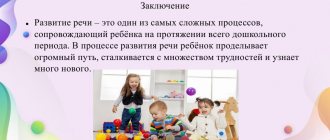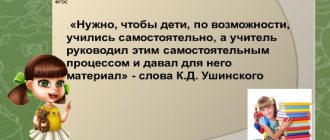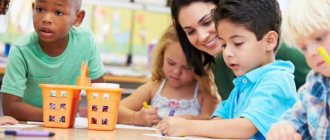Self-analysis on the applique. Topic “Scarf for Tanya”
GCD Self-Analysis
with children of the second youngest group.
Topic: “Scarf for Tanya”
Integration of educational areas:
“Artistic and aesthetic”, “Speech development”
Target
: teach children to apply previously acquired knowledge and skills and apply them in practice.
Tasks:
Educational
: learn how to stick ready-made figures on your own, lay out the future pattern.
Educational:
develop the ability to hold a brush correctly, imagination, thinking, fine motor skills, knowledge of colors (red, green, yellow)
Educational:
cultivate responsiveness, accuracy when doing work, and interest in creative activities.
Types of children's activities:
educational, playful, communicative.
Materials
: album sheets (square), glue, brushes, napkins, ready-made figures (triangles, squares, circles), sample, stands for brushes, Tanya doll.
Methods and techniques:
—
Surprise moment.
-Creation of a game situation, artistic expression.
-Finger gymnastics
-Help from the teacher: questions, demonstration, praise.
The lesson was carried out in accordance with the notes. The summary is taken in accordance with the objectives of the main educational program “From birth to school”, corresponding to the given age of children. To implement the task, techniques were selected that help solve software problems in an interesting way.
Introductory part: organization of children, motivation for upcoming activities. At the organized stage of the GCD, the problem-situational method was used. The children were asked to help Tanya. For the lesson, it was proposed to read Agnia Barto’s poem “Ball”,
The main part was a special organization and independent activity of children aimed at solving the problem.
The final part summarized the activities. She reinforced the positive results of the session with verbal encouragement.
When working with children, I used conversation, artistic expression, questions for children to test their intelligence and logical thinking - all this contributed to the effectiveness of the educational activity.
At NOD I used the following forms of work: frontal, individual, group.
Throughout the entire NOD, I tried to maintain children's cognitive interest through emotional and expressive speech. Addressing children. I used accessible questions. I believe that the goal I set has been achieved, the tasks have been accomplished.
Self-analysis was compiled by teacher Asanova Z.R.
Head of MDOU Matveeva L.O.
"May kindergarten "Solnyshko"
Self-analysis of the final lesson in the 2 ml group
Self-analysis of GCD Titova E. A.
Lesson topic: “Magic feather.”
Integration of educational areas “Speech development”, “Cognitive development”, “Physical development” and “Artistic and aesthetic development”.
Duration 15 min. /corresponding SANPIN requirements.
During the lesson the following tasks were expected to be solved:
Educational:
- expand and activate vocabulary; train in the pronunciation of onomatopoeias;
Educational:
- develop the ability to use accumulated knowledge, visual and auditory attention in a conversation;
Educational:
– cultivate responsiveness, the ability to listen to each other; promote the development of positive emotions.
To successfully solve the identified problems, I prepared the following demonstration material: a feather, pictures of poultry. Handout: ready-made paper blanks for chicken, glue, brush, napkin. He helped me reveal the topic in a bright, interesting and informative way.
To ensure children's interest in the topic and emotional response to it, I used the motivation to find out where the magic feather will lead us.
The lesson consisted of two parts. First: strengthening the understanding of poultry and their chicks; consolidation of the formation of verbs from onomatopoeia (quack-quack - quacks, ku-ka-re-ku - crows, etc.)
;
strengthening the ability to choose words that are opposite in meaning (antonyms)
; encourage children to answer questions; develop children's coherent speech. Second: consolidating children’s understanding of the structural features of birds; Carefully gluing the chicken body parts.
To solve the first problem, I used verbal methods: explanation, reminder, demonstration, questions, visual methods: pictures of poultry. To solve the second problem I used.
Visual methods: pictures of a chicken, ready-made paper blanks for a chicken, glue, brush, napkin.
Throughout the entire lesson, I paid attention to the children’s speech: I sought complete answers, posed searching questions, created conditions for dialogue with the children, etc.
To satisfy the physical activity of the children and maintain their health, I organized physical education, I constantly monitored the seating of the children.
During the lesson, the children were active, remained interested, and were attentive.
To summarize the lesson, I involved the children in this and asked them to speak on the topic: “Who did we meet in the poultry yard?” Was able to create a situation of success.
Throughout the entire NOD, I tried to support children’s cognitive interest with emotional and intonationally expressive speech. When addressing children, I used accessible questions. She took into account the individual capabilities of each child. I believe that the goal I set has been achieved, the tasks have been fully realized.
Self-analysis GCD consultation (junior group) on the topic
Introspection
Direct educational activities were carried out with children of the second youngest group, aged from 2.5 to 3 years. There are 8 children. Duration 15 minutes.
Integration: GCD is built taking into account the integrative approach, which involves the implementation of the tasks of the educational areas “Speech development”, “Artistic and aesthetic development”, “Social and communicative development”, “physical development”.
When developing this outline of educational activities, I, first of all, took into account: the age, mental and individual characteristics of the children of this group. Taking all this into account, I determined: goals, objectives, content, form of educational activities, methods, techniques and means necessary for positive results.
I was assigned the following tasks:
Educational:
-continue to compare two objects in size, length and height using the application method, denoting the comparison results with the words: high - low, higher - lower, large, small, long short.
-improve the ability to navigate in space, consolidate knowledge of the concepts: right, left;
- introduce the concept of “equally”.
Educational:
- develop thinking and general motor skills.
Educational:
— to cultivate children’s interest in joint activities and mathematics, kindness
To successfully solve the identified problems, I prepared the following materials: demonstration: toys - nesting dolls of different sizes, two paths of different lengths, an apple tree with apples.
— handout: strips, nesting dolls (3 each) of different heights, sets of geometric shapes, apples of different sizes.
He helped me reveal the topic in a bright and interesting way.
To ensure children’s interest in the topic and emotional response to it, I created the problematic situation “The bunny received an invitation to visit...”.
I used the following methods in my work: Verbal - was used throughout the educational activity (when creating game motivation, when solving a problem situation) Practical - when solving a problem situation (The bunny brought cubes for each of you and asks you to make houses for squirrels from them: house -square, and the roof is a triangle). The method of control and stimulation is in the form of approval and praise.
The methods used correspond to the material being studied and the ways of organizing children's activities in accordance with the level of the group.
The proposed tasks were given to children in a playful way, which contributed to the solution of the assigned development tasks: thinking, motor skills.
Completing various game tasks created a positive, emotional background for the learning process, increased children’s speech activity and maintained interest throughout the entire educational activity.
Throughout the entire activity, the children were responsive, friendly and completed all tasks with great pleasure.
Analyzing the children’s activities, I would like to note that they showed cognitive activity, reacted emotionally, and used existing knowledge and skills. They were interested, attentive, organized. Encouraged indecisive and shy children to speak out.
Analyzing the educational activities carried out, we can say that the assigned tasks were successfully completed. I believe that the activities are structured logically, and the stages are interconnected.
Self-analysis of the final GCD in the second junior group “Journey to the magical land of mathematics”
Tatyana Korochkova
Self-analysis of the final GCD in the second junior group “Journey to the magical land of mathematics”
Self-analysis of the final lesson in the second junior group No. 11.
Topic: “ Journey to the magical land of mathematics ”
Date: 05/18/2021
Number of children: 16
Educator: Korochkova Tatyana Yakovlevna
The lesson was carried out in accordance with the notes. The abstract was compiled independently , in accordance with the objectives of the basic general education program, corresponding to the given age of the children. Form of organization: frontal, individual
Goal: To identify the level of acquired knowledge of elementary mathematical concepts .
Educational:
- Improve the ability to distinguish and name geometric shapes (circle, square, triangle, three-dimensional figures - ball and cube;
— Strengthen the ability to compare objects by color (same - different, quantity (one, many, none), size (large-small)
and indicate the comparison results with appropriate words;
— Improve the ability to single out one item from a group .
Educational:
- develop the ability to distinguish and name primary colors;
- develop thinking: learn to see in a drawing what figures it consists of;
Educational:
- cultivate interest in mathematics , independence ;
- cultivate dedication, the ability to complete the work started.
To implement each task, techniques were selected to help solve software problems entertaining For each moment of the lesson, visual aids were selected that stimulated and activated children’s mental activity. The manuals are of sufficient size and aesthetically designed. Their placement and use was rational, well thought out in the learning space . During the lesson, children were offered a variety of activities: cognitive, social-communicative, productive, gaming. Lesson structure: consists of three parts, all of them are interconnected by one theme.
2 of the children did not fully master the material .
In the future, individual work with these children is planned.
The duration of the lesson complies with hygiene standards for young children - 15 minutes . Air, heat and sanitary conditions were observed.
The lesson is dynamic, it includes techniques that provide for a quick change of activity. Guessing riddles while sitting on chairs, an outdoor game. I believe that the program tasks set during the lesson were solved. In the final part of the NOD, they decided to give sunshine to the inhabitants of a magical land , and paid attention to the sunshine of each child.
When analyzing the GCD, we discussed with the children what geometric shapes you met, how many flowers and butterflies there were in the meadow, what we gave to the residents of the magical land , and whether you liked the trip .



